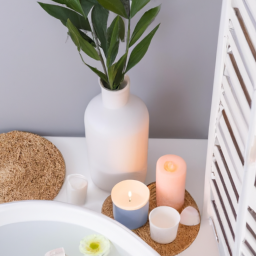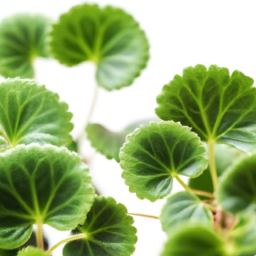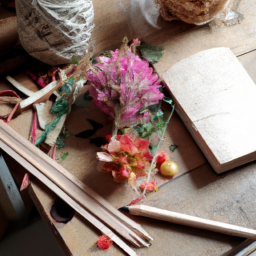
Have you ever wanted to bring the beauty of nature into your home? If so, you’re in luck! In this blog post, we’ll be exploring the world of botanical DIY: crafting with natural elements. From creating stunning floral arrangements to making your own scented candles with botanical ingredients, there are endless possibilities for incorporating nature into your crafting projects. Whether you’re a seasoned DIY enthusiast or just starting out, this post will provide you with inspiration and tips on how to create unique and beautiful crafts using natural elements. So, grab your scissors, gather some flowers and leaves, and let’s dive into the wonderful world of botanical DIY!
The Benefits of Botanical DIY: Exploring the Healing Properties of Natural Elements
Introduction
Welcome to the wonderful world of botanical DIY! In this guide, we will delve into the captivating realm of crafting with natural elements and explore the numerous benefits it offers. From enhancing our well-being to unleashing our creativity, botanical DIY allows us to connect with nature and harness its healing properties. So, let’s roll up our sleeves and embark on this exciting journey together!
Connecting with Nature
Botanical DIY provides us with a unique opportunity to connect with nature on a deeper level. In our fast-paced modern lives, we often find ourselves detached from the natural world. Engaging in botanical DIY projects allows us to slow down, immerse ourselves in the beauty of natural elements, and appreciate their intricate details.
Whether it’s collecting fallen leaves, foraging for wildflowers, or cultivating our own herbs, the process of gathering botanical materials connects us to the earth and its cycles. This connection has a profound impact on our well-being, promoting relaxation, reducing stress, and increasing our overall sense of happiness.
Moreover, spending time in nature has been scientifically proven to improve our mental health. The sights, sounds, and smells of the natural world stimulate our senses and evoke positive emotions. By incorporating natural elements into our DIY projects, we can bring a piece of nature into our homes, creating a calming and rejuvenating environment.
Unleashing Creativity
Botanical DIY is a fantastic way to unleash our creativity and express ourselves through crafting. The abundance of natural materials available to us offers endless possibilities for artistic exploration. Whether we are creating botanical jewelry, pressed flower art, or herbal skincare products, the only limit is our imagination.
Working with natural elements allows us to experiment with colors, textures, and shapes that are inherently unique and beautiful. Each leaf, petal, or seed holds its own story, and incorporating them into our DIY projects adds a touch of magic and individuality.
Moreover, botanical DIY encourages us to think outside the box and find innovative ways to repurpose materials. By upcycling fallen branches, dried flowers, or discarded plant pots, we not only reduce waste but also give new life to these forgotten treasures. The satisfaction of transforming something ordinary into an extraordinary piece of art is truly unparalleled.
Exploring Healing Properties
One of the most fascinating aspects of botanical DIY is the exploration of the healing properties of natural elements. Throughout history, plants have been used for their medicinal and therapeutic benefits. By incorporating them into our DIY projects, we can harness their healing powers and enhance our well-being.
For example, creating herbal teas or infusing oils with dried herbs allows us to enjoy their soothing and healing properties. Lavender promotes relaxation, chamomile calms the mind, and peppermint aids digestion. By crafting with these botanical ingredients, we not only create beautiful products but also reap the benefits of their natural healing properties.
In addition to herbs, essential oils derived from plants are widely used in botanical DIY. From lavender and eucalyptus to rosemary and lemon, each essential oil carries its own unique aroma and therapeutic effects. By incorporating them into homemade candles, skincare products, or bath salts, we can create a spa-like experience in the comfort of our own homes.
Conclusion
Botanical DIY is a captivating and rewarding journey that allows us to connect with nature, unleash our creativity, and explore the healing properties of natural elements. By engaging in botanical crafts, we not only enhance our well-being but also foster a deeper appreciation for the world around us.
So, let your imagination bloom, gather your favorite botanical materials, and embark on your very own botanical DIY adventure. Discover the magic that lies within natural elements and let them inspire you to create beautiful, meaningful, and truly unique pieces of art.

Creating Botanical Art: Using Natural Elements to Craft Beautiful Decorations
Welcome to the world of botanical DIY! In this guide, we will explore the art of crafting beautiful decorations using natural elements. Whether you are a seasoned DIY enthusiast or just starting out, this step-by-step guide will help you unleash your creativity and create stunning botanical art pieces. So, let’s dive in and discover the magic of crafting with natural elements!
Choosing the Right Natural Elements
The first step in creating botanical art is to choose the right natural elements for your project. Nature offers a wide variety of materials that can be used in crafting, such as flowers, leaves, branches, and even rocks. When selecting your materials, consider the color scheme, texture, and overall aesthetic you want to achieve. Experiment with different combinations to find the perfect balance.
For floral arrangements, opt for fresh flowers or dried flowers for a long-lasting effect. If you prefer a more rustic look, you can also incorporate dried leaves, twigs, and pinecones. The key is to gather materials that resonate with your artistic vision and complement the overall theme of your space.
Once you have collected your natural elements, it’s time to prepare them for crafting. Remove any excess dirt or debris and gently clean the materials to ensure they are in their best condition. This step will help preserve the beauty and longevity of your botanical art.
Exploring Different Techniques
Now that you have your natural elements ready, let’s explore some popular techniques for creating botanical art:
1. Pressed Flower Art: Pressed flower art involves drying flowers and preserving their delicate beauty. To create pressed flower art, you will need a flower press or heavy books, parchment paper, and patience. Simply place the flowers between layers of parchment paper and press them tightly using the press or books. Leave them to dry for a few weeks, and once they are fully dried, you can use them to create stunning floral arrangements, framed art, or even handmade cards.
2. Nature Printing: Nature printing is a technique that involves using natural elements as stamps to create unique patterns and textures. Gather leaves, flowers, or even fruits with interesting shapes and textures. Apply paint or ink to the surface of the natural element and press it onto paper or fabric. Experiment with different colors and arrangements to create captivating designs.
3. Terrariums and Botanical Jewelry: Terrariums and botanical jewelry are great ways to incorporate natural elements into your everyday life. Terrariums are small glass containers that house miniature gardens. Fill them with moss, small plants, and decorative elements like rocks or seashells. Botanical jewelry involves encapsulating dried flowers or leaves in resin to create one-of-a-kind accessories like pendants or earrings.
Finishing Touches and Displaying Your Botanical Art
Once you have completed your botanical art piece, it’s time to add the finishing touches and find the perfect spot to display it. Consider framing pressed flower art or nature prints to protect them from dust and enhance their visual appeal. For terrariums and botanical jewelry, make sure to seal them properly to preserve the natural elements.
When it comes to displaying your botanical art, the possibilities are endless. Hang framed pieces on walls, place terrariums on shelves or tables, or wear your botanical jewelry with pride. Let your creativity guide you in finding the ideal spot that showcases your art and brings a touch of nature into your living space.
Remember, botanical DIY is all about embracing the beauty of nature and creating unique pieces that reflect your personal style. So, gather your natural elements, explore different techniques, and let your imagination run wild. Enjoy the process of crafting with natural elements and watch as your creations transform your space into a botanical oasis!
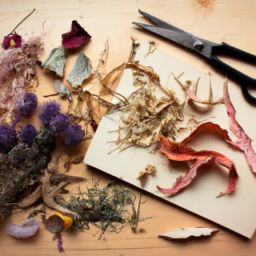
Sustainable Crafting: How to Incorporate Botanical DIY into an Eco-Friendly Lifestyle
Welcome to the world of sustainable crafting! In this guide, we will explore how you can incorporate botanical DIY into your eco-friendly lifestyle. Crafting with natural elements not only allows you to create beautiful and unique pieces but also helps reduce waste and promote a more sustainable way of living.
1. Choosing Sustainable Materials
When it comes to botanical DIY, the first step is to choose sustainable materials. Opt for natural elements that are readily available and have a minimal environmental impact. For example, you can gather fallen leaves, twigs, and flowers from your garden or local park. Avoid using rare or endangered plants, as this can contribute to their depletion.
Additionally, consider repurposing materials you already have at home. Look for old glass jars, wooden boxes, or fabric scraps that can be transformed into beautiful containers or display pieces for your botanical creations. By reusing and upcycling, you reduce the demand for new materials and minimize waste.
Remember, sustainability is all about making conscious choices that have a positive impact on the environment. By selecting sustainable materials, you are taking a significant step towards a greener lifestyle.
2. Creating Botanical Crafts
Now that you have chosen your sustainable materials, it’s time to get creative and start crafting! There are endless possibilities when it comes to botanical DIY, so let’s explore a few popular ideas:
a) Pressed Flower Art: Collect a variety of flowers and leaves, press them between heavy books for a few weeks, and use them to create stunning artwork. Frame your pressed flowers or incorporate them into greeting cards, bookmarks, or even jewelry.
b) Natural Dyes: Experiment with natural dyes made from plants to add color to fabrics, yarns, or even paper. For example, onion skins can create a beautiful golden dye, while avocado pits and skins can produce a lovely pink hue. Explore different plant materials and dyeing techniques to achieve unique and eco-friendly results.
c) Botanical Candles: Create your own candles using natural waxes, such as soy or beeswax, and add dried flowers, herbs, or essential oils for a botanical touch. Not only will these candles fill your space with a delightful aroma, but they will also add a touch of nature to your home decor.
These are just a few examples, but the possibilities are truly endless. Feel free to experiment and let your creativity guide you. Remember to document your process and share your creations with others who are interested in sustainable crafting.
3. Sharing and Inspiring Others
One of the most rewarding aspects of botanical DIY is the opportunity to share your creations and inspire others to adopt a more eco-friendly lifestyle. Here are a few ways you can spread the word:
a) Social Media: Share photos of your botanical crafts on social media platforms like Instagram or Pinterest. Use relevant hashtags to connect with like-minded individuals and eco-conscious communities. Engage with others by commenting on their posts and exchanging ideas.
b) Workshops and Events: Consider hosting workshops or participating in local craft fairs to showcase your botanical DIY skills. Teach others how to create their own sustainable crafts and encourage them to embrace a greener way of living.
c) Gift Giving: Share your botanical creations as thoughtful and sustainable gifts for friends and family. Not only will you be giving them something unique and handmade, but you will also be introducing them to the world of sustainable crafting.
By sharing your knowledge and passion for botanical DIY, you can inspire others to incorporate sustainable practices into their own lives. Together, we can make a positive impact on the environment and create a more sustainable future.
So, are you ready to embark on your botanical DIY journey? Remember to choose sustainable materials, get creative with your crafts, and share your creations with others. Happy crafting!
Let’s bring it all home
Are you looking for a creative way to bring nature into your home? Look no further than botanical DIY crafts! Crafting with natural elements is not only a fun and relaxing activity, but it also allows you to incorporate the beauty of the outdoors into your everyday life. Whether you’re a seasoned crafter or just starting out, there are endless possibilities for creating unique and stunning pieces using leaves, flowers, and other botanical elements.
One popular project is creating pressed flower art. This technique involves carefully selecting and pressing flowers between heavy books to preserve their delicate beauty. Once the flowers are dried, you can arrange them into beautiful designs and frame them for a stunning piece of wall art. Another idea is to create botanical candles by embedding dried flowers or herbs into melted wax. Not only will these candles fill your home with a lovely scent, but they will also add a touch of natural elegance to any room.
If you’re feeling adventurous, you can even try your hand at making botanical jewelry. By encasing tiny dried flowers or leaves in resin or glass, you can create one-of-a-kind pendants, earrings, or bracelets that will make a statement wherever you go. The possibilities are truly endless when it comes to crafting with natural elements, so let your imagination run wild and bring a little bit of nature into your home with these beautiful DIY projects.
Common Questions and Answers:
Q1: What is botanical DIY?
A1: Botanical DIY refers to the practice of creating crafts and projects using natural elements such as flowers, leaves, branches, and other botanical materials. It allows you to incorporate the beauty of nature into your creative endeavors, adding a touch of organic charm to your creations.
Q2: What kinds of projects can I make with botanical DIY?
A2: The possibilities with botanical DIY are endless! You can make stunning floral arrangements, wreaths, pressed flower art, botanical jewelry, natural skincare products, herbal teas, and even botanical-infused candles. The key is to let your imagination run wild and explore the various ways you can incorporate natural elements into your crafts.
Q3: Where can I find botanical materials for my DIY projects?
A3: You can find botanical materials for your DIY projects in a variety of places. Start by exploring your own backyard or local parks for flowers, leaves, and branches. You can also visit farmers’ markets, garden centers, or botanical gardens for a wider selection of botanicals. Online stores and craft shops may also carry dried flowers, essential oils, and other botanical supplies.
Q4: Are there any special techniques or skills required for botanical DIY?
A4: Botanical DIY projects can range from simple to more advanced, so there’s something for everyone regardless of skill level. While some projects may require specific techniques, such as flower pressing or candle making, many botanical crafts can be enjoyed by beginners too. The important thing is to have a willingness to experiment, learn, and let your creativity guide you.
Q5: Are there any safety considerations when working with botanical materials?
A5: When working with botanical materials, it’s important to consider safety. Some plants may cause allergic reactions or skin irritations, so it’s a good idea to wear gloves when handling unfamiliar botanicals. If you plan to consume botanicals in teas or skincare products, make sure to research their safety and potential interactions with medications. Additionally, be mindful of fire safety when incorporating botanicals into candles or other flammable materials.
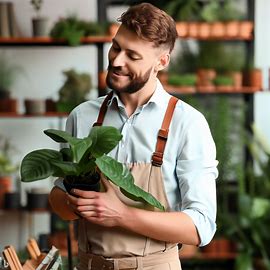
Alex Turner is a sustainable gardening advocate and the founder of an acclaimed indoor gardening blog. With a focus on eco-friendly practices and urban sustainability, Alex combines his background in environmental studies with his love for plants to educate readers on mindful indoor gardening. His work highlights the importance of nurturing both plants and the planet.

